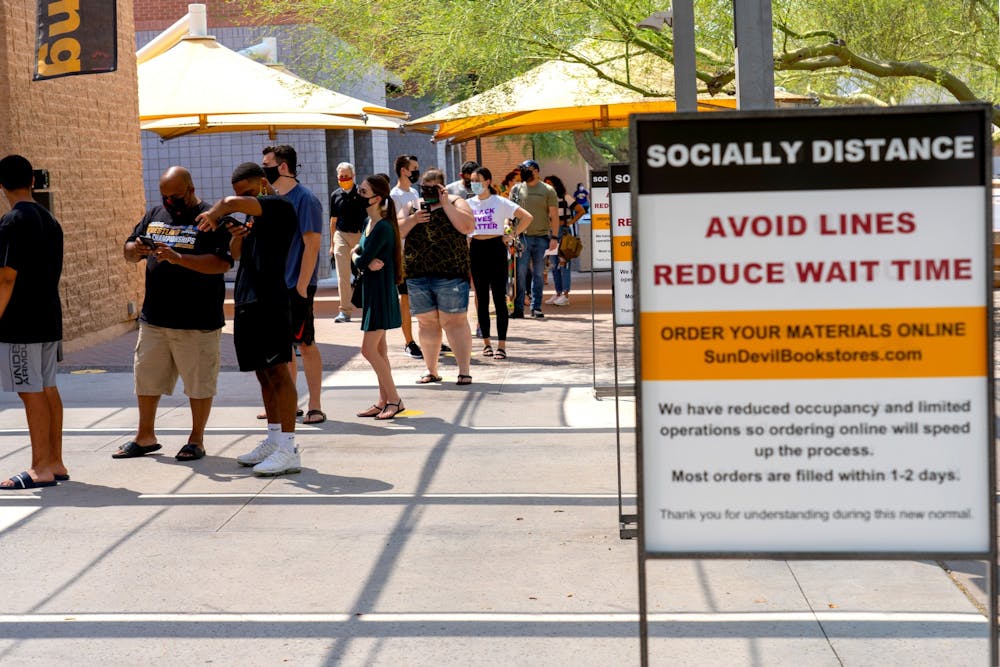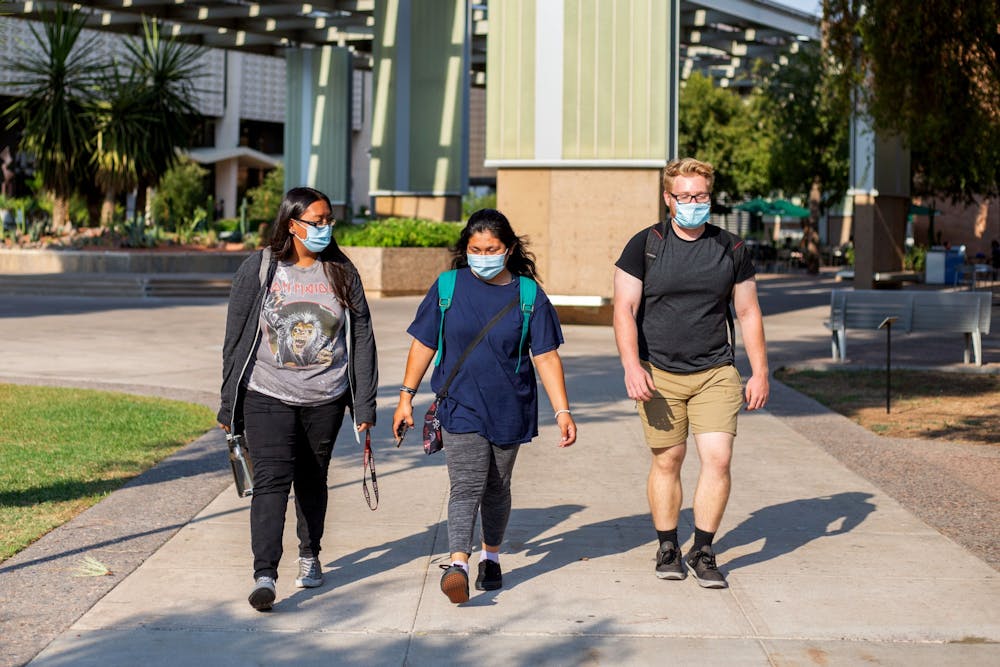For the first time since March, the University held thousands of in-person classes. But campuses are different than they were six months ago – Tempe's walkways nearly empty, the Memorial Union not crowded, hand sanitizer stations on every corner and posters, stickers, signs encouraging safety were plastered throughout halls and walkways.
ASU's fall semester began Thursday with some of the expected daily activities of college for those who returned: in-person classes, the ability to meet professors and classmates and stopping to get food afterward.
"I really enjoyed being in the classroom again and walking on campus," said Michelle Flores, a senior majoring in political science and philosophy who attended an in-person class. "But there's always that risk (when attending in-person)."
Not every student and professor was on campus. Many attended and conducted classes through Zoom, so some students attended a class in person, then headed to Hayden Library to Zoom into another.
ASU is offering courses in three modalities this fall: in-person, ASU Sync and iCourses. ASU Sync allows students to alternate between going to class in person or attending through Zoom on a rotating schedule specific to the course and the instructor. Students can opt to take all of their classes offered through ASU Sync over Zoom.
“I feel that this will impact those who are seeking a higher education the greatest, for the better,” said Anthony Washington, a junior studying business statistics, about the future of remote learning, which has become prominent amid the pandemic.
Flores said only six of 40 students in her class attended in person. Many of the students who attended through ASU Sync were not able to hear students in the class or the instructor when they walked away from the podium.
"It seems like the Zoom portion of the class is probably not going to get the full scope of what is happening (in the room)," Flores said.
Van Leeson, a junior studying supply chain management said he was taking the majority of his courses through ASU Sync. He said his first-day sessions were “simple Zoom meetings.”
Around 9 a.m. Thursday morning, some confused students took to social media when MyASU, where Zoom links for classes are located, temporarily crashed. Leeson said the lag on MyASU in the morning threw everyone off and the realization of having half the class in person and the other half online set in.
Noah Delgado, a senior studying journalism, said one of his larger seminars went well, but the chat feature through Zoom was hard to manage.
Taking his courses through ASU Sync was a serious, conscious choice, Delgado said. He explained he has high-risk family members and it was “hard to manage anxiety” about returning to any in-person interactions.
"Our way of life has been disrupted in a way that none of us anticipated and none of us could have predicted,” Delgado said. “And the ramifications of that are going to be unpredictable."
The University spent tens of millions of dollars providing new technology and ensuring students and employees have access to hand sanitizer, face coverings and COVID-19 testing equipment and supplies in preparation for the upcoming semester, according to a University spokesperson.
"We'll see how this semester continues," said Michelle Decker, a senior majoring in museum studies who was on the Tempe campus. "But I do see that there (are) things in place that make me feel comfortable."
Not all students felt the same. Flores had concerns about the cleaning precautions after attending her in-person class. Another class had been conducted before hers in the same space, and she saw no indication that it had been cleaned, nor was her class given the opportunity to clean it themselves, something University officials have said would be encouraged.
Andrea Amavisca, a junior studying environmental engineering, said she was relieved to be able to attend classes remotely. She said her first class was sort of complicated; the professor was not sure how to get the Zoom going for students, like Amavisca, who opted to take classes remotely.
Amavisca said hearing the other students in the physical room, and even the professor, was difficult but not something that she thinks will last through the whole semester.
Leeson said he expects technology issues to be a recurring theme as students get back to a normal schedule again but was certain it can run smoothly for the rest of the semester.
Ahead of the start of the semester, the University "rehearsed and stress-tested the technical environment," a University spokesperson said. The University said it is confident in its technology infrastructure to support all needs of the 125,000 students enrolled this year, a 7% increase from Fall 2019 enrollment.
Students on campus said they hope the semester goes well, but they are prepared to go remote once again if necessary. Across the country, other universities such as the University of North Carolina at Chapel Hill and Notre Dame have made the decision to return to remote learning after infections rose on-campus after students returned for the fall. Many ASU students are concerned the same may happen at the University.
"The uncertainty of the rest of the semester is daunting," Delgado said. "And I hope that I’m not alone in that feeling."
Flores worries that since the University is choosing to not make public the amount of cases or the test positivity rate within the ASU community, students and employees will be left in the dark if cases begin to rise.
"It's just better for us to have all the information," Flores said. Because by having the numbers, individuals and the community can "decide what steps we want to take" going forward, she added.
Decker said that she is optimistic for the semester, but recognizes the risk of returning and is "anticipating" the transition to remote learning.
"Because of the current state of COVID-19, online learning in some form is necessary for me and other students," Leeson said. "It is necessary to minimize, or at least reduce, the amount of people on-campus."
Reach the reporters at pjhanse1@asu.edu and wmyskow@asu.edu and follow @piperjhansen and @wmyskow on Twitter.
Like The State Press on Facebook and follow @statepress on Twitter.

Wyatt Myskow is the project manager at The State Press, where he oversees enterprise stories for the publication. He also works at The Arizona Republic, where he covers the cities of Peoria and Surprise.

Piper Hansen is the digital editor-in-chief at The State Press, overseeing all digital content. Joining SP in Spring 2020, she has covered student government, housing and COVID-19. She has previously written about state politics for The Arizona Republic and the Arizona Capitol Times and covers social justice for Cronkite News.





